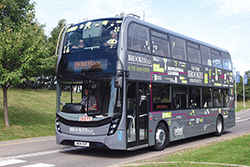
There are more hybrid buses in operation in the United Kingdom than in any other European country. Although the greatest numbers of hybrid buses are operating in London, others are running in many other parts of the country. Governments in London and Edinburgh have stimulated their purchase by paying much of the difference in price (compared to cheaper conventional diesel buses) with Green Bus Funds.
The level of subsidy has gradually come down because bus companies have become more confident about the technology and are achieving impressive savings in fuel consumption. Considering the high price of diesel in the UK and most European countries, these funds are a major incentive.

In the early days, there were concerns as to the life of the batteries and the cost of their replacement. It would not have made sense to replace the batteries in mid-life, where the cost might well have been more than the value of the complete vehicle.
There is now competition between battery suppliers who are prepared to maintain and replace batteries for a fixed price per mile, similar to tire contracts.
Until now, BAE Systems, Siemens, Volvo with its own in-house system, as well as a small number of Allison units were the main suppliers of hybrid drive systems in the UK.
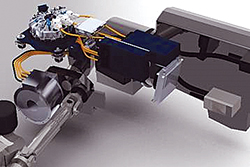
The technology is has been continually refined. For example, Arrive & Go from BAE Systems switches off the small diesel engine as the vehicle approaches a stop. The bus arrives and goes in all-electric mode, silent and emission-free, which is a big benefit to people in the vicinity of bus stops. The diesel engine does not switch on again until some distance after departing.
The Formula 1 racing team Williams has worked for some time on flywheel technology to boost performance and improve fuel efficiency. A change in F1A regulations meant this technology could no longer be used in racing cars, but Williams successfully applied it to the Audi R18 that won the 24-hour LeMans race three times — one of the most grueling endurance tests in the automotive world.
Williams also saw the potential to fit the system in buses as they stop and start so frequently. The company worked with Go-Ahead, one of the largest British bus groups, to retrofit the system in a Volvo double-decker bus running in London. Go-Ahead was able to compare it directly with standard diesel and full-hybrid buses.
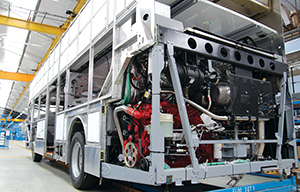
Sufficiently impressed with the savings in fuel and emissions, Go Ahead talked about fitting the flywheel hybrid drive as standard in new buses. This was probably a step too far for Williams, because it meant that the whole production process would have to be industrialized. It would also distract from the core competencies of Williams in racing and high-performance cars.
Williams Hybrid Power sold in April to GKN, a 250-year old company and one of the UK’s largest engineering groups with interests in automotive drivelines, off-highway systems, aerospace and special metals.
Based near Oxford, GKN Hybrid Power employs more than 40,000 people and operators in more than 30 countries. In the United States, it manufactures drive shafts, brakes, clutches and wheels.
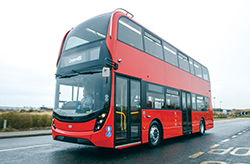
“This acquisition is an opportunity for GKN to take a unique technology to global markets,” says a company spokesperson. “It helps solve the emissions and efficiency challenges faced by mass transit companies around the world.”
Within weeks, Go-Ahead placed an order with GKN Hybrid Power to supply 500 Gyrodrive systems — an electric carbon fiber flywheel that offers a highly efficient energy transfer back and forth between the flywheel and the drivetrain.
The Gyrodrive system is light and compact. It can be packaged anywhere on the vehicle and is equally suitable for transverse and in-line engine applications. GKN says that the flywheel system is a fraction of the weight of battery-based hybrid systems.
In a bus application, the flywheel has no physical connection to the engine or drivetrain.
Instead, a motor harvests the energy normally lost during braking and turns this into electrical power to charge the flywheel, which spins at up to 36,000 rpm when fully charged. The flywheel can reverse the process, releasing stored energy to power the motor, helping to accelerate the bus back up to regular speed. The system generates savings of more than 20 percent at a significantly lower cost than battery hybrid alternatives.
GKN supplies the flywheel, the advanced EVO electric motor, an in-house-designed and manufactured gearbox, and it provides the installation. Designed and built to last the life of the bus, it eliminates the need for any battery changes.
The first of those were installed in a fleet of 14 Alexander Dennis Enviro400 double-decker buses that entered service in early September at Go-Ahead’s Oxford subsidiary. Painted in a special color scheme, the buses provide services to and from Oxford Brookes University (not to be confused with the world-famous Oxford University).
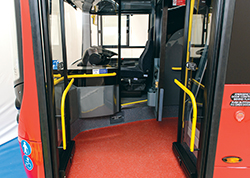
The Alexander Dennis double-decker buses are the first of a new generation to go into service. The Enviro400 has been around for several years, but the company decided to make many improvements to coincide with the introduction of Euro VI engines.
GKN claims further benefits over battery systems, such as the ability to operate in a broader range of temperatures, from -20ºC to 45ºC, not that we get those extremes in the United Kingdom. Storage and handling at zero charge state is intrinsically safer than for a typical partially or fully-charged high-voltage battery.
In the United Kingdom, bus companies running regular services, but not express services, receive a rebate on some of the duty paid on diesel. Vehicles certified as being low carbon receive a larger rebate. All hybrid buses and the GKN system qualify.
GKN reckons that the payback period for the Gyrodrive is between four and six years, and that all subsequent mileage is a bonus. Bearing in mind that most of our service buses have at least a 15-year life, that is a major benefit.
In a project codenamed MMC (Major Model Change), customers invited to a series of design clinics at the main factory in Scotland were asked about their experience with the previous generation and the improvements they wanted. When they visited the factory for what they thought was a further round of consultations, they were pleasantly surprised to find a complete prototype with many of new features incorporated.
These included new electrical circuitry that makes it easier to trace faults; a new heating system located centrally under the staircase and novel glazing for the main side windows.
The new model is available at optional heights of 13 feet, 9 inches; and 14 feet, 2 inches, both with the same interior headroom. The lower height is achieved by mounting the body directly onto the chassis frame and by using a new sandwich construction between the decks.
It is also available in three different lengths, all on two axles: 33 feet, 11 inches; 35 feet, 9 inches; and 37 feet, 9 inches. Primarily for the London market, the shortest version is available with two double-width doors. Maximum seating capacity in the longest model is 86.
As with all Alexander bodies, the structure is aluminum. Despite the greater weight of the Euro VI engine, and especially its cooling system, the overall weight was reduced compared with the previous model. Early tests demonstrated a 12 percent reduction in fuel consumption.
The GKN Gyrodrive is also available in the Enviro200 single-deck midibus, the same design that is being promoted by New Flyer as the MiDi. The first examples are due to go into service very soon.
The Gyrodrive is not exclusive to Alexander Dennis by any means. In its promotional material, GKN states that installation solutions are also available for Optare midibuses, the Mercedes-Benz Citaro and Scania OmniCity heavy-duty single-deck buses and a Volvo double-decker bus.
There is at least one other flywheel hybrid project in development in the UK, but the GKN solution is the first to go into volume production. Furthermore, with its strong export activities, GKN is in a good position to promote the Gyrodrive in many other markets.
Doug Jack is with Transport Resources in the United Kingdom.
